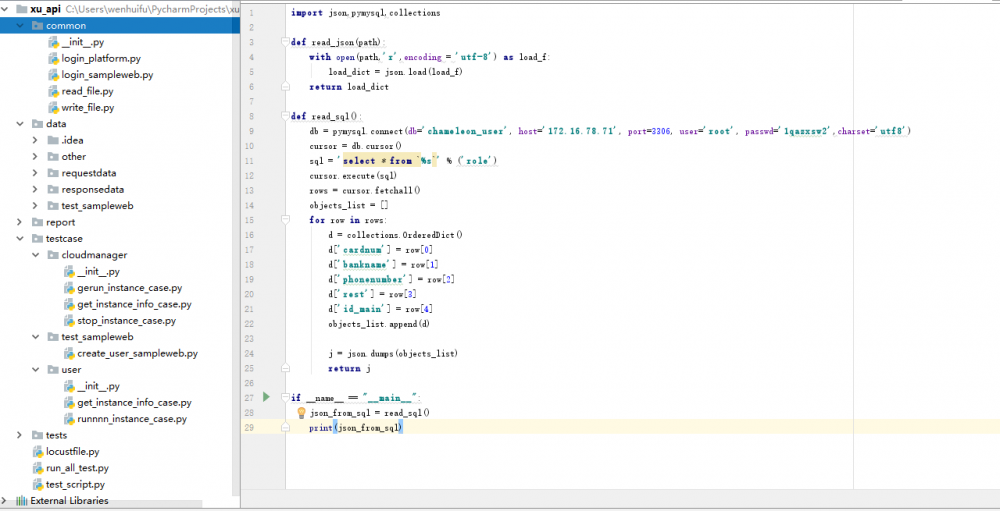微服务平台API测试
| 编辑推荐: |
| 本文来自于csdn,本文介绍了在微服务平台API测试过项目结构和代码过程等相关内容,希望对您的学习能有所帮助。 |
1.项目结构是这样的。

2.通用函数代码
import json,pymysql,collections
def read_json(path):
with open(path,'r',encoding = 'utf-8') as load_f:
load_dict = json.load(load_f)
return load_dict
def read_sql():
db = pymysql.connect(db='chameleon_user', host='172.16.78.71', port=3306, user='root', passwd='1qazxsw2',charset='utf8')
cursor = db.cursor()
sql = 'select * from `%s`' % ('role')
cursor.execute(sql)
rows = cursor.fetchall()
objects_list = []
for row in rows:
d = collections.OrderedDict()
d['cardnum'] = row[0]
d['bankname'] = row[1]
d['phonenumber'] = row[2]
d['rest'] = row[3]
d['id_main'] = row[4]
objects_list.append(d)
j = json.dumps(objects_list)
return j
if __name__ == "__main__":
json_from_sql = read_sql()
print(json_from_sql)
3. 登陆代码
import requests
import json
class login():
headers = {'Content-Type': 'application/json;charset=utf-8',
'token': 'planceholder',
'User-Agent': 'Mozilla/5.0 (Windows NT 10.0; Win64; x64) AppleWebKit/537.36 (KHTML, like Gecko) Chrome/65.0.3325.181 Safari/537.36',
'userId': 'planceholder'
}
def __init__(self):
self.login_url = 'http://172.16.78.72:8301/v1/chameleon-user/user/login'
self.form_data = {'account':'admin',
'password':'zs123YL!'}
def get_login_token(self):
try:
r = requests.post(self.login_url,headers=self.headers,data = json.dumps(self.form_data))
login_return_dicts = r.json()
self.headers['token'] = login_return_dicts['token']
self.headers['userId']= str(login_return_dicts['data']['userId'])
#print(login_return_dicts)
except:
print('登陆平台失败!获取Token失败')
return
if __name__ == '__main__':
l = login()
l.get_login_token()
print(login.headers['token'])
print(login.headers['userId'])
4.模块运行
# coding=utf-8
import requests,sys
import unittest
import json
from common.read_file import read_json as readjson
from common.login_platform import login as login
login = login()
login.get_login_token()
class RunInstance(unittest.TestCase):
def setUp(self):
self.headers = login.headers
self.instance_data = readjson(r'C:/Users/wenhuifu/ PycharmProjects/xu_api/Data/cloudmanager /RunInstance.json')
self.url = 'http://172.16.78.73:3011/api /chameleon-cvg/instance'
#@unittest.skip('不测试!')
def test_run_instance(self):
try:
r = requests.post(self.url,headers = self.headers,json = self.instance_data)
print(r.json())
except:
#print(err)
print('创建机器失败!')
assert r.status_code == 200
def tearDown(self):
pass
if __name__ == '__main__':
create = RunInstance()
create.test_run_instance()
5.生成测试报告
from HTMLTestRunner_PY3 import HTMLTestRunner
from email.mime.text import MIMEText
from email.header import Header
import smtplib
import unittest
import time
import os
#发送邮件
def send_mail(file_new):
f = open(file_new,'rb')
mail_body = f.read()
f.close()
msg = MIMEText(mail_body,'html','utf-8')
msg['Subject'] = Header("自动化测试报告",'utf-8')
smtp = smtplib.SMTP()
smtp.connect('smtp.126.com')
smtp.login("username@126.com","123456")
smtp.sendmail("username@126.com", "receive@126.com",msg.as_string())
smtp.quit()
print('Email has been send out!')
def new_report(testreport):
lists = os.listdir(testreport)
lists.sort(key = lambda fn:os.path . getmtime (testreport + "//" + fn))
file_new = os.path.join(testreport,lists[-1])
print(file_new)
return file_new
if __name__ == "__main__":
now = time.strftime("%Y-%m-%d %H_%M_%S")
filename = './Report/' + now + ' result.html'
fp = open(filename,'wb')
runner = HTMLTestRunner(stream=fp,title = 'XU API Test Result',description= '环境 Windows 10')
discover = unittest.defaultTestLoader.discover ('./Testcase',pattern= '*_case.py')
runner.run(discover)
fp.closed
6.测试报告还是很直观的。

正文到此结束
热门推荐
相关文章
Loading...











![[HBLOG]公众号](https://www.liuhaihua.cn/img/qrcode_gzh.jpg)

